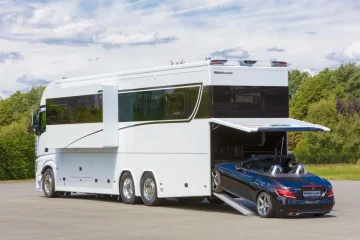Owning a Used RV can be a fantastic way to explore the open road and enjoy countless adventures. However, to keep your RV running smoothly and safely, regular maintenance is key. Whether you’re a seasoned RVer or new to the RV lifestyle, having a comprehensive maintenance checklist can help you stay organized and proactive in caring for your vehicle. In this guide, we’ll cover essential maintenance tasks that every used RV owner should prioritize.
1. Exterior Inspection
Start by conducting a thorough exterior inspection of your RV. Check for any signs of water leaks, especially around windows, doors, and roof seams. Inspect the roof for cracks, tears, or damaged caulking that could lead to water infiltration. Examine the exterior walls for cracks, dents, or delamination. Don’t forget to inspect the awning for tears or wear and tear. Lastly, check the condition of your tires, including tread depth, sidewall cracks, and proper inflation.
2. Interior Inspection
Move on to the interior of your RV and inspect for any water damage. Look for stains, soft spots, or musty odors that could indicate leaks. Check the functionality of windows and doors, ensuring they seal properly. Test all appliances such as the refrigerator, stove, oven, microwave, and air conditioner to make sure they are in working order. Check plumbing fixtures like sinks, faucets, toilets, and showers for leaks or malfunctions. Also, test the electrical systems, including outlets, switches, and circuit breakers.
3. HVAC System Maintenance
Proper maintenance of your heating, ventilation, and air conditioning (HVAC) system is crucial. Clean or replace HVAC filters regularly to maintain air quality and system efficiency. Check and clean air vents and ducts to ensure proper airflow. Inspect the furnace and air conditioner for any signs of damage or malfunction, and test the heating and cooling systems to ensure they are working correctly.
4. Propane System Check
If your RV is equipped with a propane system, it’s important to inspect it regularly. Check propane tanks for leaks, rust, or damage. Inspect propane lines, fittings, and connections for signs of wear or deterioration. Test propane appliances such as the stove, oven, furnace, and water heater for proper operation.
5. Plumbing System Maintenance
Maintaining your RV’s plumbing system is essential for avoiding leaks and water damage. Check for leaks or drips in plumbing fixtures, pipes, and connections. Inspect the water pump and water heater for proper operation and leaks. Periodically flush and sanitize the fresh water tank to prevent buildup. Don’t forget to check and clean sewer hoses, valves, and connections.
6. Electrical System Inspection
A functioning electrical system is crucial for your RV’s operation. Test batteries for voltage levels and charging capacity. Inspect and clean battery terminals and connections. Check and replace any blown fuses or faulty circuit breakers. Test all interior and exterior lights for proper functionality.
7. Chassis and Engine Maintenance
Regular maintenance of your RV’s chassis and engine is essential for safe travels. Check engine oil levels and perform regular oil changes. Inspect belts, hoses, and filters for signs of wear and replace as needed. Check brake pads, rotors, and brake fluid levels. Inspect suspension components such as shocks, struts, and springs. Test the operation of windshield wipers, washer fluid, and horn.
8. Seal and Caulk Maintenance
Inspect all seals and caulking around windows, doors, vents, and seams. Repair or replace any damaged or deteriorated seals and caulking to prevent water leaks and damage.
9. Safety Equipment Check
Regularly test smoke detectors, carbon monoxide detectors, and fire extinguishers to ensure they are in working order. Check emergency exit windows and doors for proper operation. Inspect and replace safety equipment batteries as needed.
10. Regular Cleaning and Care
Finally, don’t forget about regular cleaning and care for your RV. Clean and wax the exterior to protect against UV damage and maintain appearance. Clean interior surfaces, upholstery, and carpets regularly to prevent dirt buildup and odors. Clean and lubricate slide-out mechanisms, hinges, and locks. Store your RV in a covered or sheltered area when not in use to protect against weather elements.
Conclusion
By following this comprehensive RV maintenance checklist, used RV owners can stay proactive in caring for their vehicles and ensure a smooth and safe RVing experience. Regular inspections, maintenance tasks, and cleaning routines are essential for preserving the condition, performance, and value of your RV. Remember that proper maintenance not only enhances your enjoyment of the RV lifestyle but also contributes to the longevity and reliability of your beloved home on wheels. Happy travels!



